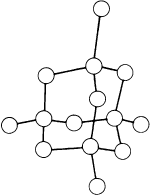The hardest known mineral (with a hardness of 10 on Mohs’ scale). It is an allotropic form of pure carbon that has crystallized in the cubic system, usually as octahedra or cubes, under great pressure. Diamond crystals may be colourless and transparent or yellow, brown, or black. They are highly prized as gemstones but also have extensive uses in industry, mainly for cutting and grinding tools. Industrial diamonds are increasingly being produced synthetically.
See rhombus.
The hardest known mineral (with a hardness of 10 on the Mohs scale). It is an allotropic form of pure carbon that has crystallized in the cubic system, usually as octahedra or cubes, under great pressure. Diamond crystals may be colourless and transparent or yellow, brown, or black. They are highly prized as gemstones but also have extensive uses in industry, mainly for cutting and grinding tools. Diamonds occur in ancient volcanic pipes of kimberlite; the most important deposits are in South Africa but others are found in Tanzania, the USA, Russia, and Australia. Diamonds also occur in river deposits that have been derived from weathered kimberlite, notably in Brazil, Zaïre, Sierra Leone, and India. Industrial diamonds are increasingly being produced synthetically.

Diamond
Crystalline form of carbon that is the hardest naturally occurring material (hardness 10 on Mohs’s scale); sp. gr. 3.5; cubic; white or colourless, sometimes yellow, green, red, and rarely blue or black; crystals octahedral; cleavage perfect {111}; of igneous origin and frequently associated with kimberlites.